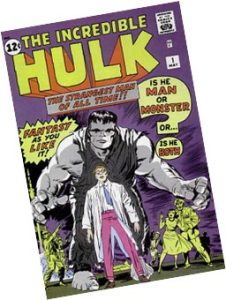30
What are comics?
For some, it is any image drawn in a certain cartoony style; for others, it is any combination of image and text (this can include anything from children’s books to airline flight safety cards). Some consider any sequence of images like cave paintings or Medieval tapestries as comics, while others associate the medium with the genres of humor or fantasy.
Definition (according to the Norman Rockwell Museum)
Comic books are serialized stories, often contained in an already preconceived universe. Some are continuously written and illustrated by a wide range of artists, changing every few years, to give way to a new artistic concept or storyline.
Graphic novels are ever-before told stories, generally compiled into one single volume. However, the term includes ‘novel’; not all graphic novels are fiction. Many are also memoirs, which may be written and illustrated by the same person, instead of a team.
Early Days: 50,000 BCE – 1895 CE
Several art forms influenced the medium that became what we know as comics today.
Platinum Age: 1896-1938
The Precursors to Comics
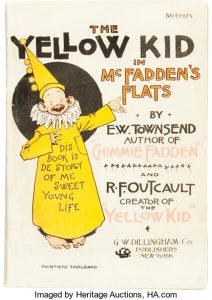 “The Yellow Kid” by Richard Fenton Outcalt (1896, UK)
“The Yellow Kid” by Richard Fenton Outcalt (1896, UK)
- First to use speech balloons
- First to be called a “Comic” book (due to its humor)
- Story told in comic strips
- The format was then copied by others
American Editorial Cartoons

“Stop them damn pictures. I don’t care so much what the papers write about me – my constituents can’t read. But dammit, they see pictures.”
—William Marcy Tweed, 1871
 Zorro
Zorro
Phantom

Golden Age: 1938-1955
Heroes Go To War
The First Comic Book Superhero
 It’s a bird . . .
It’s a bird . . .
It’s a plane . . .
No, it’s Superman!
Superman first appeared in Action Comics in 1938. He was created by Jerry Siegel and Joe Shuster in 1932. Both the children of Jewish immigrants, they came up with the character as two teenagers attending high school in New York City. Superman’s secret identity is Clark Kent (named after actors Clark Gable and Kent Taylor), a reporter at The Daily Planet newspaper in Metropolis. He was born Kal-El on doomed planet Krypton to parents Jor-El and Lara. His weakness is kryptonite (shards of his exploded birth planet. At first, he is only able “to leap tall buildings in a single bound,” but his powers kept increasing until he could fly in space.
Comic books were first created by Jewish immigrants/refugees. Enter Jerry Siegel, an aspiring teenage writer, and Joe Shuster, a young would-be artist – both nerdy, alienated Jewish misfits many decades before that was remotely cool. They developed their idea of a superhuman alien from a dying planet who would fight for truth and justice. Barely out of childhood themselves, the boys’ idea was rejected by the newspaper syndicates as naive, juvenile and unskilled, before [printing salesman Maxwell] Gaines bought their 13 pages of Superman samples for Action Comics at 10 bucks a page – a fee that included all rights to the character. Siegel and Shuster had created a new archetype – or perhaps, more accurately, a new stereotype.
“As comic writers we had to have villains in our stories. And once World War II started, the Nazis gave us the greatest villains in the world to fight against.” -Stan Lee (born Stanley Martin Lieber)
Superman actualized the adolescent power fantasies of these two Depression-era kids, who craved a muscle-bound redeemer to liberate them from the social and economic impoverishment of their lives and, in the tradition of the Golem of Prague, to fight anti-Semites.
The narrative is rich in Jewish symbolism. Superman’s parents sent him to Earth in a tiny rocket ship, reminiscent of how baby Moses survived Pharaoh’s decree to kill all Jewish newborn sons. In the context of the 1930s, the story also reflected the Kindertransports – the evacuation to safety of hundreds of Jewish children from Nazi-occupied Europe to lands of the British Commonwealth.
“We couldn’t get into newspaper strips or advertising; ad agencies wouldn’t hire a Jew. One of the reasons we Jews drifted into the comic book business is that most of the comic book publishers were Jewish. So there was no discrimination there.” -MAD magazine cartoonist Al Jaffee
 Superman’s Foil
Superman’s Foil
The First Female Superhero
 Government Propaganda
Government Propaganda
During the war period, comic book consumption skyrocketed. The government discovered the value of comic books as a medium. They were ideal for the American government in disseminating patriotic and anti-Japanese and anti-Nazi ideals, without seeming too close to actual propaganda. The new world order made heroes and villains in comics the perfect recruitment technique. Captain America was ahead of the curve in that sense.
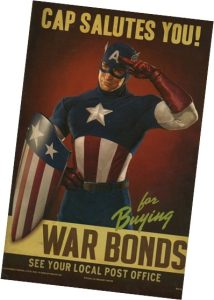 By 1944, comic books were so popular that around 44% of men in the Army identified themselves as avid comic book readers. Superheroes following in the footsteps of Captain America became poster boys for Americans fighting in World War II, and because of that, their stories became explicit tools of propaganda. This was due to the fact that the Office of War Information (OWI) created what became known as the WWB (Writer’s War Board). Although it was not explicitly in the government’s payroll, had its offices and guest editors provided for by the OWI.
By 1944, comic books were so popular that around 44% of men in the Army identified themselves as avid comic book readers. Superheroes following in the footsteps of Captain America became poster boys for Americans fighting in World War II, and because of that, their stories became explicit tools of propaganda. This was due to the fact that the Office of War Information (OWI) created what became known as the WWB (Writer’s War Board). Although it was not explicitly in the government’s payroll, had its offices and guest editors provided for by the OWI.
Through the WWB, the U.S. government co-opted comic books as an essential means of disseminating race-based propaganda to adult Americans, including members of the Armed Forces. Working with comic creators, the WWB crafted narratives supporting two seemingly incompatible wartime policies: racializing America’s enemies as justification for total war and simultaneously emphasizing the need for racial tolerance within American society.
The Comic Boom
Between 1940-1945, four hundred superheroes were created. There were three types of comic books: science fiction, detective, and jungle adventure. Comics were now printed in the magazine style we now know.
 The Comic Controversy
The Comic Controversy
In the 1950s, a witch hunt occurred when psychiatrist Frederic Wertham wrote the book The Seduction of the Innocent about the comics causing adolescent delinquency, inciting violence, and promoting “homosexual ideals.” A Comics Code was created to limit what could/could not appear in print. This censorship frenzy and parent panic led comic book companies to cancel some of their most popular titles and several superhero storylines were continuously censored. As a result, production became very sparse. Storylines became less complicated and political, and gimmicks like animal superheroes and celebrity figures joined adventures across the DC and Marvel universe.
The Silver Age: 1955-1970
Cold War, Censorship, & Controversy
After the end of WWII, comic book sales declined. This was due to multiple factors: soldiers in the armed forces going back home and giving up comic books, comic book stories becoming less complex due to censorship, and other media consumption increasing.
Then, one man came along who would change comics forever.
 Stan Lee, Founder of Marvel Comics
Stan Lee, Founder of Marvel Comics
“The Marvel Method” allowed for greater collaboration between artists and writers. This period saw the rise of complex heroes. With darker storylines and more human personalities, these characters became more identifiable and marketable than the exhausted simplistic and invisible superhero that had characterized the boom of the 1940s and ’50s. The 1960s also ushered in the creative underground of comics, with artists with more innovative and sometimes risky designs, which led people like Wertham and many other mainstream political actors to denounce comics as immoral and subversive to “good American ideals.”
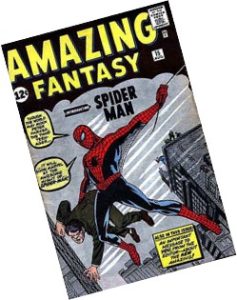 The First Teenage Superhero
The First Teenage Superhero
Spider-Man first appeared in Amazing Fantasy in 1962. He was created by writer-editor Stan Lee and writer-artist Steve Ditko. His secret identity is Peter Parker, a high school science nerd who is bitten by a radioactive spider and gains its powers. He works at the Daily Bugle, not Daily Planet, as a photographer, not a reporter. Other characters in his story are Aunt May, J. Jonah Jameson (boss), Mary Jane Watson, Gwen Stacy, Flash Thompson, and Harry Osbourne. He fights villains like The Green Goblin, Doctor Octopus, The Lizard, Electro, The Kingpin, Mysterio, The Rhino, and Kraven the Hunter.
The First Monster Superhero
 The First Disabled Superhero
The First Disabled Superhero
Daredevil first appeared in an eponymous comic in 1964. He was created by writer-editor Stan Lee and artist Bill Everett (with help from Jack Kirby). His secret identity is Hell’s Kitchen lawyer Matt Murdock. In his story, he was blind(ed by radiation) as a kid, but the accident left his other senses heightened.. He becomes a lawyer by day while fighting crime like Batman/Spider-man using his other, greatly enhanced senses. Other characters in his story are Jack Murdock, Foggy Nelson, and Karen Page. He fights villains like The Kingpin, The Fixer, Bullseye, and Electra.
The First Technology-Based Superhero
The Bronze Age: 1970-1985
Comics Questioning Authority
The Bronze Age marked a sharp shift from the previous eras:
- Relatively few new characters were introduced. Instead, old characters received gritty, “real-world” reboots.
- Censorship relaxed, allowing for more violence, political issues, and adult themes. Thanks to this, horror comics made a comeback.
- Instead of ignoring sociopolitical issues like racial prejudice, comics elevated minority characters and their experiences, although controversial.
- Artistic styles also became more realistic to reflect these changes, which allowed comics to further evolve.


The First Black Superhero
Black Panther, the “King of the Jungle,” first appeared in the Fantastic Four #52 in 1966. He later appeared in the Jungle Action comics. He was reated by writer-editor Stan Lee and penciller/co-plotter Jack Kirby. His secret identity is T’Challa, King of the (fictional) African nation of Wakanda.

The First Black Superhero to Have Their Own Comic

The Dark Ages: 1985-2000
Diversity and Moral Complexity
In this period, comic book characters generally became darker and more psychologically complex.
Gritty Superheo Realism
Superhero Makeovers
Characters got “reboots” to try to fix the fact that people had been writing stories about them for many decades. Rebooting meant you could add anything you liked, remove anything that seemed kind of silly, and change whatever you felt like.
 Comic Sales
Comic Sales
At Marvel, someone got smart and decided they could take the suit (a temporary Spider-man sales gimmick) and make a modern anti-hero called Venom. He debuted in 1987.
Then, someone got greedy. Here’s a picture of five alien symbiotes at once. There are fourteen different symbiotes in total in Spider-Man-related comics. Audiences can smell “greedy” and can start resenting parting with their money.

 This resulted in a comics sales boom, but then the glut of titles started to hurt the market. Spider-Man and Superman would have four titles a month each. Marvel got greedy with a ridiculous number of X-Men/mutant-related books, pumped out thoughtlessly like sausages. Every X-title referred to events in every other X-title that month, so you were supposed to buy them all.
This resulted in a comics sales boom, but then the glut of titles started to hurt the market. Spider-Man and Superman would have four titles a month each. Marvel got greedy with a ridiculous number of X-Men/mutant-related books, pumped out thoughtlessly like sausages. Every X-title referred to events in every other X-title that month, so you were supposed to buy them all.
Due to oversaturating the market, comic book sales were in crisis by the mid-1990s. Both of the largest comic book companies, Marvel and DC, were in trouble financially. By the late 1990s, Marvel had declared bankruptcy.
“DC Kills Death”
To grab massive sales, D.C. advertised in 1992 that they would kill Superman. Sales rocketed to see this happen and to buy the last few issues with Superman alive in them. Superman’s death was mentioned on the news.
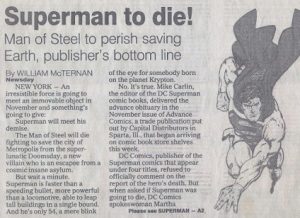
 Here come the Supermen! Instead of the Superman story ending, it continued (in about four different interlocked-story titles each month) with an army of “Is one of these the real Superman, returned from the dead?” characters. Sales continued to benefit from reader interest in what the heck D.C. was up to.
Here come the Supermen! Instead of the Superman story ending, it continued (in about four different interlocked-story titles each month) with an army of “Is one of these the real Superman, returned from the dead?” characters. Sales continued to benefit from reader interest in what the heck D.C. was up to.
 Newsflash: Superman doesn’t die. Superman shows up, not dead, and with a 90s mullet. Readers felt cheated. Sales plummeted despite pretty much every single comic book character ever created then getting killed off and brought back in a vain attempt to recreate the sales of the “Death of Superman” storyline/trick. No one believed comic book death anymore. If a character was in danger, you knew they could actually die and they’d be fine anyway.
Newsflash: Superman doesn’t die. Superman shows up, not dead, and with a 90s mullet. Readers felt cheated. Sales plummeted despite pretty much every single comic book character ever created then getting killed off and brought back in a vain attempt to recreate the sales of the “Death of Superman” storyline/trick. No one believed comic book death anymore. If a character was in danger, you knew they could actually die and they’d be fine anyway.
Meanwhile, over at Marvel, the company survived bankruptcy but had to scale back comic books heavily. Instead, it shifted its focus to TV/movies and merchandise (toys, clothing, etc.).
Non-Superhero Comics
Another 90s trend was comic books that don’t feature any superheroes. These books were marketed toward adults, with extremely graphic, horror-based imagery, but were not so much about macho fighting as psychological, political, mythological, or theological content. They didn’t just have boobs and drugs and people getting shot but were terribly intelligent also. And cleverly vulgar.
The Modern Age: 2000+
A Whole New Millenium
Comic Book Adaptations
For most millennials and members of generation X, their knowledge of Marvel and DC characters comes not from books, but movies. Comic books and graphic novels proved to be profitable fodder for film and television adaptations. This has become a major area of income for companies that once published comic books. Mergers (Marvel with ABC/Fox/Disney/Pixar/Lucasfilm (Star Wars) and DC Comics with Warner Brothers/CW/New Line Cinema/Turner/Cartoon Network/Castle Rock/Boomerang) also provided new streams of revenue into the once-small businesses.

 Diversity
Diversity
Comic books and graphic novels have responded to calls for diversity in the 21st century. Fans want diverse representation, so comic book companies have added or changed characters who are:
- Women, transgender, or nonbinary
- Racial minorities and mixed-raced
- Physically or neurologically different
- Disabled
- Immigrants or refugees
Case Study:
Agent Carter
Synopsis
Margaret “Peggy” Carter was a British operative acting as a liaison to U.S. Army, specifically the Strategic Scientific Reserve.
World War II
Peggy served under Colonel Chester Phillips in the S.S.R. during WWII. She was assigned as a liaison from the British government to help combat Hitler’s top-secret science division Hydra.
She first met Steve Rogers at Colonel Phillips’ training base and oversaw his and the other potential candidates’ training for Operation: Rebirth. When Rogers was selected as the candidate, she escorted him to the U.S. Army’s secret base in Brooklyn under a pawnshop. After Dr. Erskine was murdered during Rogers’ successful transformation, she followed the Rogers and the spy into the streets of Brooklyn and fired off several rounds into the car that the spy was escaping in.
Colonel Phillips was given a new assignment to take the S.S.R. to Europe to take the fight directly to Hydra and made Agent Carter and Howard Stark a part of his staff. Agent Carter and Howard Stark helped Captain Rogers get to his destination to the secret Hydra base that allied POWs were held. Peggy soon developed a crush for Steve, though referred to it as “having faith in him”.
She was along with the company of soldiers led by Colonel Phillips to follow Captain Rogers into Hydra’s last base of operations. After defeating Schmidt, Captain Rogers flew the Hydra plane into the Atlantic region. During his descent, he expressed his grief about not being able to make his date with Agent Carter to her over the military radiofrequency.
In the final days of World War II, Peggy Carter led the SSR and the Howling Commandos in capturing one of Hydra’s last outposts in Austria. As the outpost’s senior officer, Werner Reinhardt was taken into custody, he reminded her of Hydra’s motto – “cut off one head, two more shall take its place.”, she retorted that they’ll just keep cutting their heads off. As Carter’s men boxed up the dangerous devices at the facility, including the Obelisk, she suggested that there should be a peacetime organization dedicated to keeping such devices in their care, and to keep an eye on those who would use them. Werner Reinhardt was imprisoned in a facility known as “the Rat,” where Agent Carter would routinely interrogate the prisoner. After several attempts to offer his services to the SSR, Agent Carter informed Werner Reinhardt he would remain in the prison alone for the rest of his life.
After the War
One year after Captain America’s disappearance, Agent Carter was transferred to New York City. There she moved in with another woman named Colleen O’Brien, with whom she developed a close friendship. Unfortunately, Carter also found that her boss, Chief Roger Dooley, and her male co-workers underestimated her abilities because of her sex, and was often given menial tasks.
Defending Howard Stark
Dangerous technology developed by Howard Stark eventually found its way onto the black market, and the industrialist was brought before the Senate on charges of selling these weapons to enemies of the United States. The SSR was tasked with apprehending Stark after he suddenly failed to appear at a hearing. Chief Dooley put Agent Jack Thompson in charge of the manhunt despite Agent Carter’s protests that her friend could not be guilty of the crimes he was. Although the other agents dismissed her, Carter would get her opportunity to prove Howard Stark’s innocence when he personally asked her to find the stolen technology and clear his name. However, she would have to keep her activities a secret from the SSR lest she be branded a traitor to the United States. To this end, Stark gave Peggy use of his butler and closest confidant, Edwin Jarvis.
During her investigation, Agent Carter discovered Stark’s technology was stolen by Leet Brannis, an operative of the mysterious Russian spy organization Leviathan who chose to keep what he took from Stark’s vault for himself to sell to the highest bidder rather than turn it over to his superiors. However, Peggy attracted the attention of the Leviathan agent hunting Brannis down. He followed her back to her apartment and killed Colleen before getting into a fight with her. Peggy was able to overpower the assassin, but realized she needed to find a new place to live. She eventually moved into the Griffith Hotel, a women-only boarding house where her friend Angie Martinelli also lived. Peggy and the assassin found Brannis around the same time. Although Peggy tried to keep Brannis alive so he could testify about the stolen technology, a stray bullet from the assassin fatally wounded him. Before he died, Brannis gave her a clue to where he could find the remainder of the technology he stole from Stark, which led Peggy to a boat in New York Harbor. She had Jarvis call in an anonymous tip to the SSR, who managed to recover Stark’s technology. While transporting one of Brannis’ associates guarding the technology back to the SSR’s office, Agent Ray Krzeminski was gunned down by an unknown assassin.
Agent Krzeminski’s death weighed heavily on the SSR, especially on Peggy, who blamed herself for what happened to him. Around this same time, Howard Stark returned to the United States to follow up on Peggy’s recent discoveries. He had her sneak into the SSR’s labs and recover one particular device he called “the Blitzkrieg Button,” which, if activated, would destroy New York’s power grid. Peggy thought something was off about Howard’s information, and she found inside the device a vial of blood which Howard later confirmed to be Steve Rogers’. At the same time, Chief Dooley began to look into the Battle of Finow, a massacre during World War II connected to Howard Stark where German soldiers found a Soviet camp massacred.
The SSR eventually found out about Leviathan, and Chief Dooley sent Agent Thompson to Belarus to look into any possible connection between the organization and Howard Stark. Peggy Carter convinced Chief Dooley to let her go with them when she got the Howling Commandos to participate in the mission as well. In Belarus, Agent Carter discovered Leviathan trained women to become dangerous assassins from a young age, found evidence suggesting Howard Stark had nothing to do with Leviathan, and brought one of their prisoners, Dr. Ivchenko, back to the United States. She also earned the admiration of Agent Thompson due to her bravery. However, her newfound respect among the other SSR agents came to a sudden end when another agent, Daniel Sousa, brought her secret investigation to light. Although Peggy tried to evade the SSR agents, she was eventually arrested when she was poisoned by Dottie Underwood, one of the women living at the Griffith Peggy deduced was one of Leviathan’s female assassins.
She was taken back to the SSR’s office, where Dooley, Thompson, and Sousa interrogated her. Before she could give them any information, Jarvis showed up at the SSR’s office with a fake confession from his employer. Dooley agreed to let Carter and Jarvis go only when Howard Stark turned himself in, and he fired Agent Carter from the SSR. While they were cleaning out her things, Carter and Jarvis noticed Dr. Ivchenko sending a message in Morse code with hand signals to someone in the building across the street. From what they could gather Leviathan was going to attack the office in 90 minutes. Realizing she had little time to work, Peggy gave up everything to the SSR so they would believe her about Dr. Ivchenko. Although Dooley and Thompson were skeptical, Sousa believed her and sent a team across the street to find any evidence of an impending attack against the SSR.
While they were gone, Dr. Ivchenko, a psychologist, hypnotized Chief Dooley into isolating Carter and Jarvis, and into giving him access to the recovered Stark technology in their lab. Carter and Jarvis were eventually found by Agent Thompson, who came back to the office after Dottie attacked Sousa’s team. Once he let them out of the interrogation room, they found Chief Dooley locked inside his office, asleep and wearing a glowing vest. Jarvis recognized the vest as a prototype thermal armor Howard Stark developed for winter warfare, but the vest’s power source was faulty and volatile. Since the armor’s circuitry ran throughout the vest, it could not be cut off Chief Dooley without it exploding. Chief Dooley realized he was about to die, and promised Carter to get the people who did this two him before he jumped out of the office’s window and exploded before he hit the ground.
Later that day, Carter, Thompson, and Sousa investigated a massacre at a local movie theater. Everyone in the film’s audience mauled each other to death. They soon realized this was the effect of Item 17, one of Stark’s weapons Dr. Ivchenko, which they discovered was an alias for Dr. Johann Fennhoff, stole from the SSR’s lab. While they were pondering Dr. Fennhoff’s motives, Howard Stark showed up at the office to tell them everything he knew. He developed Item 17, which he called “Midnight Oil,” in hopes that it would require soldiers to need less sleep, but never used it after he found out about its side effects. However, an American general raided his laboratory during the war and tested the chemical on the soldiers at Finow. Howard Stark also had a plan to lure Dr. Fennhoff and Dottie out of hiding. He would make a public appearance at a press conference held by the SSR clearing him of all charges.
The plan worked as Howard Stark came under fire from a sniper as he took to the podium. This was, however, a diversion, and in the chaos, Leviathan captured Howard Stark and took him to one of his hangars. Dr. Fennhoff, whose brother was one of the victims at Finow, hypnotized Howard, and tricked him into thinking he was flying towards Captain America’s signal when really he was headed towards Times Square (which was crowded due to the VE Day celebration) with a plane carrying the Midnight Oil. Agent Carter knew this was Dr. Fennhoff’s plan, and she, Thompson, and Sousa went to the hangar to stop them. Jarvis, meanwhile, took off in a plane to tail his employer so he could shoot him down in case he could not be freed from Dr. Fennhoff’s control. Peggy confronted Dr. Fennhoff and Dottie in the air control room. Dr. Fennhoff managed to escape when Dottie fought back, but Agent Sousa apprehended him before he could leave the hangar. Dottie tried to intimidate Agent Carter with the threat she would infiltrate the SSR, but Peggy kicked her out of the control room’s window, seemingly to her death. Peggy got on the radio to try and bring Stark back to reality, but had little effect on him until she brought up Captain America. Once she had him accept that Steve Rogers was dead, Stark was freed from Dr. Fennhoff’s spell, and turned the plane around. On her way out of the hangar, Peggy noticed Dottie’s body was gone.
The next day, Agent Carter was greeted at the SSR’s office as a hero; however, her thunder was taken from her when a senator arrived to give all the credit for apprehending Dr. Fennhoff. She wasn’t sure if she would return to the SSR, but Agent Sousa assured her there would always be a place for her there. Without a place to live since she was arrested at the Griffith, Howard Stark allowed her and Angie to move into one of his nearby homes. While Angie was exploring the place, Jarvis gave Peggy the vial of Steve Rogers’ blood she recovered. Peggy emptied the vial into a nearby river.
One night while alone in the office, the telephone rang, bringing intel of the location of the criminal organization known as Zodiac. She went to the Zodiac base, took out the Zodiac members single-handed and was able to retrieve a serum. After the mission, Agent John Flynn reprimanded her for not going through the proper procedures. However, the telephone rang, this time with Howard Stark on the other end. Stark informed Agent Flynn that Agent Carter would co-head the newly created S.H.I.E.L.D. and that Agent Flynn had to personally assist Agent Carter in packing her belongings.
By 1953, Peggy had gotten married. Her husband was a soldier whose life had been saved by Captain Rogers during World War II. The two would later have children.
Ant-Man
While Hank Pym was serving as a Research and Development consultant for S.H.I.E.L.D. he discovered what was later called the Pym Particles, which when used with a specialized suit would allow the operator to shrink down.
That discovery came to the attention of Howard Stark and he wanted his agents to use the particle for a covert op to shut down a suspected Hydra outpost in Berlin, but Pym declined, because he didn’t trust anyone handling his suit other than himself, in fear that it may end up in the wrong hands. Stark wouldn’t let him out on the field, but Peggy Carter changed his mind, after a small training session with Hank.
When Pym returned, he went to talk to Howard and Peggy. Stark expressed his disapproval of Pym’s decisions to destroy the technology and told Pym that it would be his last mission, but Pym responded that Berlin had proved there was more good work the Ant-Man suit could do, and only he himself would be allowed to wear it, so he asked for his next assignment.
In 1989, Peggy, Howard, and Senator Mitchell Carson had a confrontation with Pym, when he discovered that Carson had been involved in attempts to duplicate his Pym particles. Although Peggy was shocked at the discovery, when Howard attempted to justify the decision due to the military applications of the particle, Pym punched Carson and walked out of S.H.I.E.L.D., ending his affiliation with them.
Retirement
By the 2010s, Peggy, now well into her nineties, was living in a nursing home, and suffering from Alzheimer’s disease. Captain America had been found frozen in the Arctic, having not aged, and joined S.H.I.E.L.D. following the Battle for New York in which he and the Avengers saved the world from an alien invasion. He discovered Peggy was still alive and visited her in the nursing home, she gave Steve advice regarding his doubt to continue working for S.H.I.E.L.D. before forgetting he had been unfrozen and being glad that Steve had returned.
Funeral
Just as the Avengers were informed of the Sokovia Accords- which would bring them under the direct authority of the U.N.- Steve received a text informing him that Peggy had passed away in her sleep, departing the meeting to attend the funeral. As well as serving as one of Peggy’s pallbearers, he also met with Sharon Carter, Peggy’s niece, who had been assigned to keep an eye on him when he worked for S.H.I.E.L.D. Talking with Sharon after the funeral, Steve learned that Peggy had never been informed about Sharon’s role in his life, as Sharon felt that her aunt kept so many secrets already that she didn’t want her to have to keep one from Steve.
Agent Carter in Comics


Agent Carter on Film:
Disney/Marvel/ABC (2015), 2 seasons
Where to Watch:

